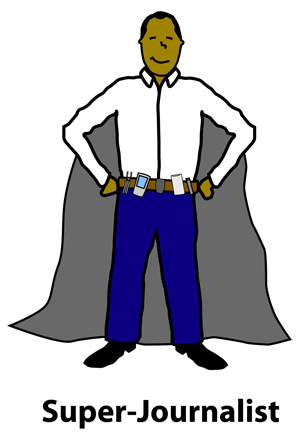 Journalists are finding success with pocket-sized tools that allow them to report on stories from almost anywhere in the world.
Journalists are finding success with pocket-sized tools that allow them to report on stories from almost anywhere in the world.
Reuters is having their reporters experiment with a “mobile journalism toolkit,” which allows reporting in text, audio, video and photos:
- The Mobile Journalism Toolkit contents, which include a Nokia N95 phone, Nokia SU-8W folding keyboard, a small tripod, Sony microphone, and solar charger.
- Background info on the mobile journalism project, and a video on how each piece of the toolkit will be used.
- A bit more on the partnership with Reuters and Nokia:
“The idea is that using the phone will mean more agility and less use of laptops and expensive camera equipment (and fewer people to enable filming); there is also a back-end system that formats the material to be posted on Reuters’ site.” - Clyde Bentley gives some of these tools, and others, a mobile reporting field test:
“I’m still confident that… our computing future is pocket-sized. But journalists will need fast, Hummer-tough units accessible to 50-something eyes and fingers. There is not much of a market for that yet.” - Mel Taylor shares his perspective on the affects of such a mobile toolkit:
“Newspaper reporters: getting out from behind their desks and reporting from the field. (where the news is breaking) They are gathering and uploading news (in all forms: text, video, stills, etc.) within a very short turn-around time. Sometimes it’s live. This trend is also an early look at how Newspaper will be able to go after juicy Broadcast and Cable advertising budgets.”
For truly live mobile reporting, Robert Scoble has embraced the idea of streaming live video from his mobile phone via a service called Qik. You can see the videos he has shot here. He comments:
“My world has just changed. Thanks Qik!… The quality isn’t the best, but it’s watchable and that’s all we really need considering that video is coming to you over a cell phone connection.”
Howard Owens feels that mobile reporting should free journalists to spend more time with the people in their beat, as opposed to commuting or in an office. His advice for someone covering a particular town or region:
“The classic image of a MoJo is a reporter sitting in his car, filing a story. Certainly, you must spend time doing that, but the less time you spend actually driving that car, the better. You need to be out and about, on foot, with people. Your job isn’t to find scandal or hard-hitting news. Your job is to unlock the life of your town in a way that print journalism hasn’t done consistently for generations. It’s all about people.”
Howard’s point is a good one. While there is so much focus on the tools of journalism, the real change is how they allow journalists to connect with their sources and help their communities.
